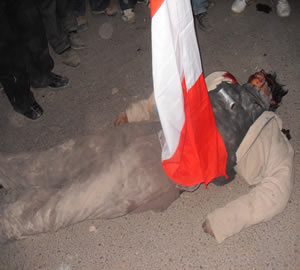On June 24th, 2011, the Peruanian police killed at least six protesters and injured more than 30 people during a demonstration against the Ramis River’s contamination from the region’s mines in Juliaca, southern Peru.
At about 11 am, residents blockaded the road leading to the city’s airport and tried to break its perimeter. Fully armed repressive forces of the National Police, and in particular the commandos of DINOES (special operations unit) opened fire against the crowd.
At about 12.00 the first fatal shots were reported while the shooting by uniformed killers continued until late afternoon, leaving dead Víctor Campos Huanca, Felix Edwin Irpanoca Turpo, Raúl Cancapa Huaricallo, Petronila Coa Huanca, Gregorio Huamán Mamani and one more person who has not been identified.
The clashes between locals and cops continued until late evening when a large number of demonstrators gathered in downtown Juliaca and attacked commercial centres and other capitalist targets.
A well-founded fear of the residents is that more demonstrators’ corpses have vanished once again by the Peruanian police, and that the total number of dead people is larger.
The regime’s media tried to justify the cops and their political assignors, presenting the protesters as outlaw and violent. The truth lies elsewhere, however. The Peruanian State and its executioners are guilty of countless crimes against nature and mankind. In the context of good cooperation with multinational companies of oil, mineral and gas extraction, as well as mega-contractors of infrastructure projects for the alleged development in Latin America, the Peruanian State systematically pursues the catastrophe of Amazonia, the poisoning of people living on Peru’s territory, and the expulsion and vanishment of isolated indigenous communities from their traditional lands.

The convenient murders of demonstrators serve the looting of Amazonia and the plundering of natural and human resources whenever those are not accomplished via excavation and drilling.
